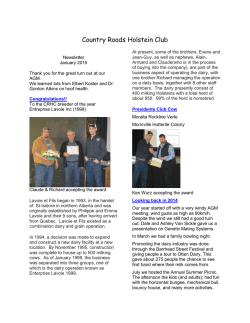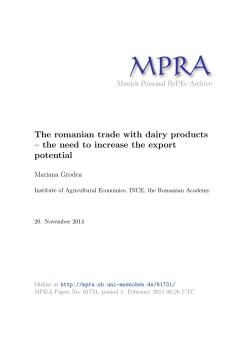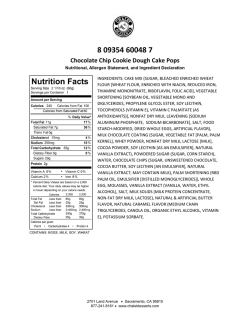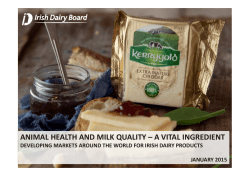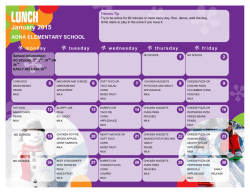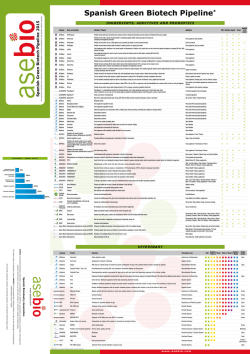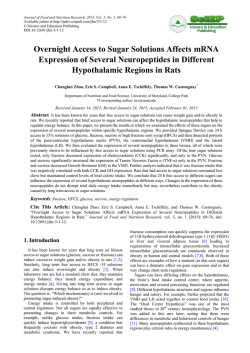
Linear Models of Nitrogen Utilization in Dairy Cows
27 Mod Nutrient ch26 30/8/00 4:28 pm Page 347 Linear Models of Nitrogen Utilization in Dairy Cows 26 E. Kebreab,1 R. Allison,2 R. Mansbridge,2 D.E. Beever1 and J. France1 1Centre for Dairy Research, Department of Agriculture, University of Reading, Earley Gate, PO Box 236, Reading RG6 6AT, UK; 2ADAS Bridgets, Martyr Worthy, Winchester SO21 1AP, UK Abstract Linear models describing relationships between nitrogen (N) intake and N output were constructed based on N-balance data from experiments conducted at the Centre for Dairy Research (CEDAR). The models were then applied to a second set of data derived from a series of N-balance experiments conducted at the Agricultural Development and Advisory Service (ADAS) Bridgets. The CEDAR models described the data from ADAS Bridgets as well as independently fitted models, despite the fact that different diets were given to the cows at the two centres. The variance explained in the ADAS Bridgets data was lower, possibly due to variations in the source and level of energy intake. The variations indicate the possibility of mitigating N losses from dairy cows by diet manipulation. Models currently used in practice underestimate N output for the two data sets and the models described herein may be useful as a basis for better estimation of N excretion. Excretion of N in faeces is preferable, due to its potentially less harmful effect on N pollution to the environment, particularly with regard to volatilization of ammonia and leaching to groundwater reserves, and future models will need to estimate faecal output and the proportion of faecal : urinary N excreted by dairy cows more accurately. Introduction There has been an increased use of protein supplements in the UK in order to improve milk production, particularly milk protein content. Increased use of protein supplements is also due to their being a cheaper source of energy than © CAB International 2000. Modelling Nutrient Utilization in Farm Animals (eds J.P. McNamara, J. France and D.E. Beever) 347 27 Mod Nutrient ch26 30/8/00 4:28 pm Page 348 348 E. Kebreab et al. traditional energy sources. Although the conversion rate of nitrogen (N) to animal product is often as low as 30–35% (Kirchgessner et al., 1994), marginal milk N responses are still achieved with increase in dietary N above 450 g N dayϪ1 (Kebreab et al., 2000). This may be because amino acids are also being used via gluconeogenesis as a source of glucose for the synthesis of extra milk fat and lactose. Excess N is excreted in faeces and urine, thus contributing to atmospheric and hydrosphere pollution (Kirchgessner et al., 1994). Average annual N excreta are estimated to be about 100 kg cowϪ1 (Smith and Frost, 2000), which, with about 2.5 million dairy cows in the UK (MAFF, 1999), significantly contributes to environmental pollution. Mathematical modelling has been used to predict the amount of N in milk and potential N losses from dairy farms and their contribution to environmental pollution. Estimates of ammonia emissions to the atmosphere are based on linear equations that predict N excretion from average milk yield and crude protein content of the diet (ECETOC, 1994). The objective of this chapter is to evaluate alternative linear models developed at the University of Reading’s Centre for Dairy Research (CEDAR), using independent N-balance experiments conducted at the Agricultural Development and Advisory Service (ADAS) Bridgets. These alternative models could ultimately be used to predict N losses from dairy farms in the UK. Materials and Methods Five N-balance experiments using Holstein-Friesian dairy cows in early or midlactation were conducted at CEDAR from 1995 to 1997. The cows were fed 30 different diet types, consisting of ten grass silages and six concentrates. The silages were made from either directly cut or partially wilted perennial ryegrass (Lolium perenne), which received either 75 or 150 kg N haϪ1. The concentrates used were formulated to give higher proportions of either degradable fibre, soluble sugars, high (barley) and low (maize) degradable starch and different protein degradabilities. The data from these experiments were collated and linear models developed, using the General Linear Modelling Procedure of Genstat (Genstat 5 Committee, 1994). At ADAS Bridgets, a series of four N-balance experiments were carried out, using early and mid-lactation Holstein-Friesian dairy cows as part of the Minimum Impact Dairy Systems (MIDaS) study (Peel et al., 1997). Each experiment was based on a Latin square design, with each experimental period being 3 weeks in duration. The first 2 weeks of each period were for diet adaptation and a total collection of faeces and urine was made during the third week. Diets were formulated using various strategies to improve the capture of dietary N in milk in order to reduce N losses to the environment. These included reducing N supply, changing the type of rumen-N supplied, investigating the amount and balance of rumen-degradable protein and fermentable energy and formulating 27 Mod Nutrient ch26 30/8/00 4:28 pm Page 349 Linear Models of Nitrogen Utilization 349 rations using the Cornell Net Carbohydrate and Protein System (CNCPS) (Fox et al., 1992). Results Over the range of 280–640 g N intake dayϪ1, there was a strong linear relationship between N intake (NI) and N in excreta (Nexcreta) for the experiments conducted at CEDAR: Nexcreta = 30 + 0.62 NI (R 2 = 0.78) (1) A similar but weaker linear relationship was established for data collected at ADAS Bridgets. By setting the value of N excretion at zero intake, as in the above equation, to aid comparison (which did not significantly affect the residual sum of squares compared with the ‘best-fit’ equation), the following equation was obtained for ADAS Bridgets data: Nexcreta = 30 + 0.63 NI (R 2 = 0.42) (2) Thus equation 1 predicts N in excreta for the ADAS experiments as well as equation 2 (Fig. 26.1). Similarly, the effect of N intake on milk output was analysed and linear models from the two sets of data were compared (Fig. 26.2). Based on the CEDAR data, N in milk (Nmilk) was linearly related to N intake (equation 3). Data Fig. 26.1. Effect of N intake on the N excreted in faeces and urine for cows from CEDAR (᭺) and ADAS Bridgets (᭡). The fitted line is given by equation 1. 27 Mod Nutrient ch26 30/8/00 4:28 pm Page 350 350 E. Kebreab et al. from ADAS Bridgets gave a similar linear relationship between milk N and N intake (equation 4). Nmilk = 38.2 + 0.19 NI (R 2 = 0.3) (3) Nmilk = 38.2 + 0.20 NI (R2 = 0.3) (4) Discussion It is surprising that empirical equations derived from CEDAR data are so applicable to ADAS Bridgets data. However, this work is consistent with observed trends in N excretion and N utilization for milk production in intensive dairy farming systems in the UK. From equations 1 and 2, about 62–63% (plus 30 g) of N fed to dairy cows in UK is excreted in faeces or urine, thus contributing directly to N pollution of the environment. This study predicts that only 19–20% of N in the diet is incorporated as milk N. The small gains from increasing N intake beyond 450 g dayϪ1 in terms of milk production are offset by more than threefold waste of N in faeces and urine. Furthermore, Lockyer and Whitehead (1990) estimated ammonia volatilization from urinary N to be at least five to six times higher than from faecal N and, at intakes of 570 g N dayϪ1, 90% of intake would be excreted in a urine : faeces ratio of 4 : 1 (Scholefield et al., 1991). Management practices and selecting appropriate types of protein and Fig. 26.2. Effect of N intake on milk N for cows from CEDAR (᭺) and ADAS Bridgets (᭡). The fitted line is given by equation 3. 27 Mod Nutrient ch26 30/8/00 4:28 pm Page 351 Linear Models of Nitrogen Utilization 351 energy sources might improve N retention and utilization. The variability in the data, especially from ADAS Bridgets, suggests that N utilization under different treatments might have been affected by feed sources as well as N intake levels. The currently used method of estimation of N loss from dairy farms is based on the crude protein content of the diet and average milk yield (ECETOC, 1994). However, comparison of the estimates with the extrapolation of N output from the above experiments shows that the method underestimates the annual N loss from dairy farms, at least in the UK. Although the linear equations reported here cannot be used directly for estimating annual N excretion, they highlight the extent of the problem and new models are required to predict N excretion and ammonia emission more accurately. Acknowledgement MAFF Environmental Protection Division is thanked for funding this work. References European Centre for Ecotoxicology & Toxicology of Chemicals (ECETOC) (1994) Ammonia Emissions to Air in Western Europe. Technical Report No. 62, ECETOC, Brussels, 196 pp. Fox, D.G., Sniffen, C.J., O’Connor, J.D., Russell, J.B. and Van Soest, P.J. (1992) A net carbohydrate and protein system for evaluating cattle diets: III Cattle requirements and diet adequacy. Journal of Animal Science 70, 3578–3596. Genstat 5 Committee (1994) Genstat 5 Release 3 Reference Manual. Clarendon Press, Oxford. Jentsch, W., Schiemann, R. and Hoffman, L. (1983) Gemeinschaftsuntersuchungen zur Präzisierung des Energie- und Proteinsbedarfs bei Mastschweinen. 2. Mitteilung: Energie- und Nahrstoffumsatz bei Masthybriden im Mastabschnitt von 30–110 kg. Archiv für Tierernährung, Berlin 33(7/8), 552–570. Kebreab, E., Castillo, A.R., Beever, D.E., Humphries, D. and France, J. (2000) The effects of management practices prior to and during ensiling and concentrate type on nitrogen utilisation and pollution in lactating dairy cows. Journal of Dairy Science 83, 1274–1285. Kirchgessner, M., Windisch, W. and Roth, F.X. (1994) The efficiency of nitrogen conversion in animal nutrition. Nova Acta Leopoldina 70, 393–412. Lockyer, D.R. and Whitehead, D.C. (1990) Volatilization of ammonia from cattle urine applied to grassland. Soil Biology and Biochemistry 22, 1137–1142. MAFF (1999) Agricultural and Horticultural Census: 1 June 1988. Government Statistical Service, York, UK. Peel, S., Chambers, B.J., Harrison, R. and Jarvis, S.C. (1997) Reducing nitrogen emissions from complete dairy farm systems. In: Jarvis, S.C and Pain, B.F. (eds) Gaseous Nitrogen Emissions from Grasslands. CAB International, Wallingford, pp. 383–390. Scholefield, D., Lockyer, D.R., Whitehead, D.C. and Tyson, K.C. (1991) A model to predicted transformations and losses of nitrogen in UK pastures grazed by beef cattle. Plant and Soil 132, 165–177. 27 Mod Nutrient ch26 30/8/00 4:28 pm Page 352 352 E. Kebreab et al. Smith, K.A. and Frost, J.P. (2000) Nitrogen excretion by farm livestock with respect to land spreading requirements and controlling nitrogen losses to ground and surface waters. Part I: cattle and sheep. Bioresource Technology 71, 173–181.
© Copyright 2025

